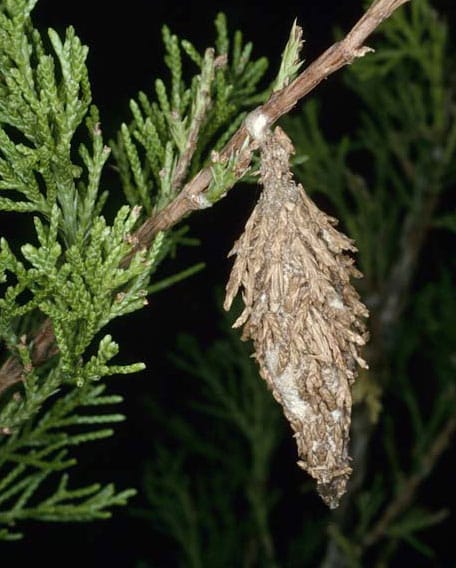Source(s):
- M.F. Potter, Extension Entomologist, The University of Kentucky College of Agriculture.
- L.H. Townsend, Extension Entomologist, The University of Kentucky College of Agriculture.
Bagworms are caterpillars that make distinctive spindle-shaped bags on a variety of trees and shrubs in Georgia. They attack both deciduous trees and evergreens, but are especially damaging to juniper, arborvitae, spruce, pine and cedar. Large populations of bagworms can strip plants of their foliage and eventually cause them to die. Infestations often go unnoticed because people mistake the protective bags for pine cones or other plant parts.
Description and Habits
Bagworms are the larval (caterpillar) stage of a moth that is rarely seen. Only the males develop into typical moths capable of flight. The adult female is grub-like and remains inside the bag until just before she dies. Bagworms pass the winter as eggs inside the bag that contained the previous year’s female. In mid to late May the eggs hatch, and the tiny larvae crawl out from the end of the bag in search of food. By using silk and bits of plant material, they soon construct a small bag around their hind part that looks like a tiny, upright ice cream cone. As the larvae continue to feed and grow, they enlarge the bag enabling them to withdraw into it when disturbed. Older larvae strip evergreens of their needles and consume whole leaves of susceptible deciduous species, leaving only the larger veins. The bag is ornamented with bits of whatever type of vegetation they are feeding upon. By early fall, the bags reach their maximum size of 1-1/2 to 2 inches. At this time the larvae permanently suspend their bags (pointing downward) from twigs, and transform into the pupa or resting stage before becoming an adult.
Adults emerge from the pupal stage in early fall. Males are black, furry, clear-winged moths with about a 1-inch wing span. They are active fliers and fly in search of females which remain inside their bags. The females produce a powerful scent, or pheromone, that attracts the males. The creamy white females lack wings and legs and appear to be no more than grubs. The male flies to the female bag, inserts his abdomen in the hole in the bottom of the bag and mates with the female. After the fertilized female has laid several hundred eggs inside her old pupal case within the bag, she drops from the bag and dies. The eggs remain in the bag until the following May when the cycle begins again. There is one generation per year. Bagworms have two means of dispersing from plant to plant. Very young larvae may spin strands of silk and be carried fairly long distances by wind. Larger larvae may move short distances by crawling.
Bagworm Control
If only a few small trees or shrubs are infested, picking the bags off by hand and disposing of them may afford satisfactory control. This approach is most effective during fall, winter or early spring before the eggs have hatched. When many small bagworms are infesting evergreens, an insecticide may be needed to prevent serious damage. The best time to apply an insecticide is while the larvae are still small (less than 1/2-inch long). In Georgia, this is usually in June. Small larvae are more vulnerable to insecticides, and inflict less damage. Carefully inspect susceptible landscape plants, especially evergreens, for last year’s bags. Young bagworms are harder to see; look closely for the small, upright bags which have the appearance of tiny ice cream cones constructed of bits of plant material. Preventive treatment is often justified on plants that were heavily infested with bagworms the previous year.
Several products are available for homeowner and professional use. For homeowners, conventional insecticides such as Sevin, malathion, various pyrethroids or the microbial insecticide Bacillus thuringiensis (Bt) provide satisfactory results. For commercial operators, acephate (Orthene TTO, Pro 75), tebufenozide (Confirm 2E), Bt (Dipel 3.2WP) and various pyrethroids work well. The BT products have very low mammalian toxicities, but are only effective against younger larvae. If large bagworms are present (more than about 3/4-inch long), a conventional insecticide probably will provide better results. The foliage should be throughly wetted with the insecticide spray in order to achieve thorough coverage. Trade names are used as examples. No endorsement is intended, nor criticism implied of similar products not named. Always read and follow directions on the label.
Resource(s): Insect Pests of Ornamental Plants
Center Publication Number: 203
